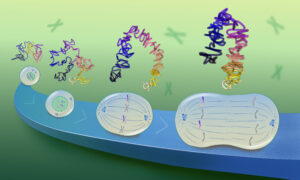
Organelles in space

This image, resembling a modern abstract painting, is a 3D-rendering of the automatic segmentation of a HeLa cell, made by Julian Hennies from the Schwab team at EMBL Heidelberg. The rendering shows mitochondria – the power generators of a cell – in red; the endoplasmic reticulum – which plays a major role in the production, processing and transport of proteins – in yellow; and the plasma membrane – which separates the interior of the cell from the outside environment – in green. The brown spots on the mitochondria indicate sites where the endoplasmic reticulum and the mitochondria come into contact with each other. The void around which the organelles organise themselves is the location of the nucleus of the cell.
Julian is using images like this to study the morphological properties of the endoplasmic reticulum, as well as contact sites that the endoplasmic reticulum forms with other organelles. To be able to study a large dataset, he relies on segmentation being done automatically using a machine-learning-based approach.
For the 3D-rendering, he used raw data from a focused ion beam scanning electron microscope volume image from the HeLa cell with a resolution of 5 × 5 × 8 nanometres.
HeLa is the oldest and most commonly used human cell line in scientific research. Originally, it was derived from cervical cancer cells taken on 8 February 1951 from Henrietta Lacks, a patient who died of cancer on 4 October 1951. The cells were taken without the permission of Henrietta or her family. At the time, Henrietta and her story were forgotten, but her cells went on to revolutionise medicine. We thank Henrietta for her legacy.
The genome of a HeLa cell line, sequenced by scientists at EMBL Heidelberg, was made available to scientists online in 2013, following an agreement between the National Institutes of Health (NIH), in the USA, and representatives of the Lacks family.
Credit: Anna Steyer & Julian Hennies/EMBL
If you have a stunning picture of your science, your lab or your site, you can submit it here.


